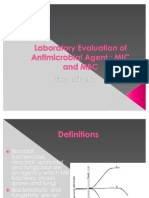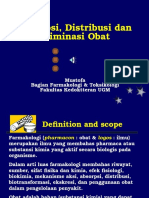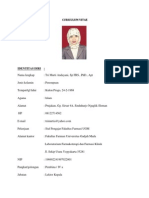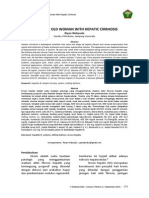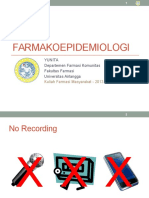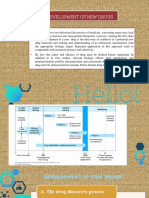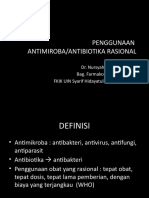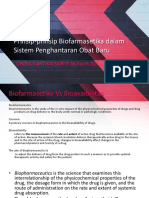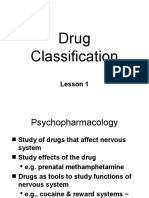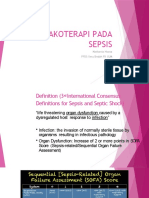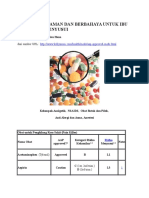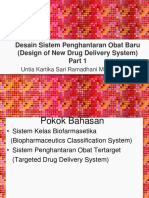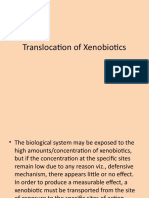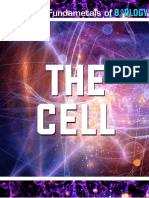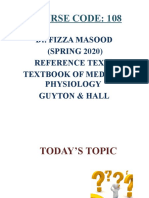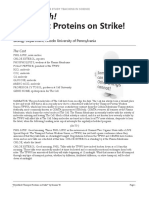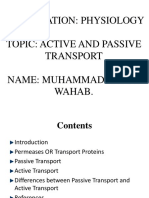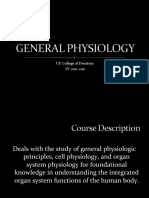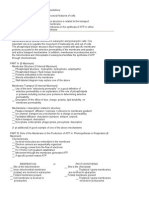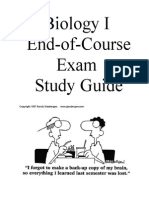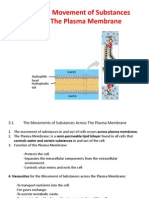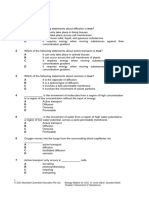0 ratings0% found this document useful (0 votes)
30 viewsToksikokinetika Absorbsi & Distribusi Toksikan: Anjar Mahardian Kusuma, M. SC., Apt
Toksikokinetika Absorbsi & Distribusi Toksikan: Anjar Mahardian Kusuma, M. SC., Apt
Uploaded by
Rossy OchieThe document discusses the absorption and disposition of toxicants in the body. It describes how toxicants can pass through cell membranes via passive or active transport mechanisms. The major sites of toxicant absorption are the gastrointestinal tract, lungs, and skin. For the GI tract, factors like pH, food, and enzymes can influence absorption. Gases and vapors are mainly absorbed in the lungs, while the absorption of aerosols depends on particle size and solubility. Membrane transporters and various passive diffusion processes also facilitate the movement and distribution of toxicants throughout the body.
Copyright:
© All Rights Reserved
Available Formats
Download as PDF, TXT or read online from Scribd
Toksikokinetika Absorbsi & Distribusi Toksikan: Anjar Mahardian Kusuma, M. SC., Apt
Toksikokinetika Absorbsi & Distribusi Toksikan: Anjar Mahardian Kusuma, M. SC., Apt
Uploaded by
Rossy Ochie0 ratings0% found this document useful (0 votes)
30 views51 pagesThe document discusses the absorption and disposition of toxicants in the body. It describes how toxicants can pass through cell membranes via passive or active transport mechanisms. The major sites of toxicant absorption are the gastrointestinal tract, lungs, and skin. For the GI tract, factors like pH, food, and enzymes can influence absorption. Gases and vapors are mainly absorbed in the lungs, while the absorption of aerosols depends on particle size and solubility. Membrane transporters and various passive diffusion processes also facilitate the movement and distribution of toxicants throughout the body.
Original Title
TOKSIKOKINETIKA
Copyright
© © All Rights Reserved
Available Formats
PDF, TXT or read online from Scribd
Share this document
Did you find this document useful?
Is this content inappropriate?
The document discusses the absorption and disposition of toxicants in the body. It describes how toxicants can pass through cell membranes via passive or active transport mechanisms. The major sites of toxicant absorption are the gastrointestinal tract, lungs, and skin. For the GI tract, factors like pH, food, and enzymes can influence absorption. Gases and vapors are mainly absorbed in the lungs, while the absorption of aerosols depends on particle size and solubility. Membrane transporters and various passive diffusion processes also facilitate the movement and distribution of toxicants throughout the body.
Copyright:
© All Rights Reserved
Available Formats
Download as PDF, TXT or read online from Scribd
Download as pdf or txt
0 ratings0% found this document useful (0 votes)
30 views51 pagesToksikokinetika Absorbsi & Distribusi Toksikan: Anjar Mahardian Kusuma, M. SC., Apt
Toksikokinetika Absorbsi & Distribusi Toksikan: Anjar Mahardian Kusuma, M. SC., Apt
Uploaded by
Rossy OchieThe document discusses the absorption and disposition of toxicants in the body. It describes how toxicants can pass through cell membranes via passive or active transport mechanisms. The major sites of toxicant absorption are the gastrointestinal tract, lungs, and skin. For the GI tract, factors like pH, food, and enzymes can influence absorption. Gases and vapors are mainly absorbed in the lungs, while the absorption of aerosols depends on particle size and solubility. Membrane transporters and various passive diffusion processes also facilitate the movement and distribution of toxicants throughout the body.
Copyright:
© All Rights Reserved
Available Formats
Download as PDF, TXT or read online from Scribd
Download as pdf or txt
You are on page 1of 51
TOKSIKOKINETIKA
ABSORBSI & DISTRIBUSI TOKSIKAN
Anjar Mahardian Kusuma, M. Sc., Apt
DISPOSITION OF TOXICANTS
The disposition of a chemical or xenobiotic is defined as the
composite actions of its absorption, distribution, biotransformation,
and elimination
Toxicants usually pass through a number of cells, such as the
stratified epithelium of the skin, the thin cell layers of the
lungs or the gastrointestinal (GI) tract, capillary
endothelium, and ultimately the cells of the target organ.
The plasma membranes surrounding all these cells are
remarkably similar. The basic unit of the cell membrane is a
phospholipid bilayer composed primarily of
phosphatidylcholine and phosphatidylethanolamine
CELL MEMBRANES
Phospholipids are amphiphilic, consisting of a hydrophilic
polar head and a hydrophobic lipid tail
In membranes, polar head groups are oriented toward the
outer and inner surfaces of the membrane, whereas the
hydrophobic tails are oriented inward and face each other to
form a continuous hydrophobic inner space
The thickness of the cell membrane is about 7–9 nm
Numerous proteins are inserted or embedded in the bilayer,
and some transmembrane proteins traverse the entire lipid bilayer,
functioning as important biological receptors or allowing the
formation of aqueous pores and ion channel
Toxicants cross membranes either by passive processes in
which the cell expends no energy or by mechanisms in which the
cell provides energy to translocate the toxicant across its membrane.
Passive Transport
.
Simple Diffusion
Most toxicants cross membranes by simple diffusion,
following the principles of Fick’s law which establishes that
chemicals traverse from regions of higher concentration to
regions of lower concentration without any energy
expenditure
Small hydrophilic molecules (up to about 600 Da) permeate
membranes through aqueous pores
hydrophobic molecules diffuse across the lipid domain of
membranes (transcellular diffusion)
Filtration
When water flows in bulk across a porous membrane, any
solute small enough to pass through the pores flows with it.
Passage through these channels is called filtration, as it involves
bulk flow of water caused by hydrostatic or osmotic force
In renal glomeruli, a primary site of filtration, these pores are
relatively large (about 70 nm) allowing molecules smaller
than albumin (approximately 60 kDa) to pass through
Special Transport
Active Transport
Active transport is characterized by: (1) movement of
chemicals against electrochemical or concentration gradients,
(2) saturability at high substrate concentrations, (3)
selectivity for certain structural features of chemicals, (4)
competitive inhibition by chemical cogeners or compounds
that are carried by the same transporter, and (5) requirement
for expenditure of energy, so that metabolic inhibitors block
the transport process.
Xenobiotic Transporters
Transporters mediate the influx (uptake) or efflux of xenobiotics
ATP-binding cassette (ABC) transporters, P-gp (P-glycoprotein)
this transporter functions as an efflux pump was the first member
The second major family of such transporters is known as solute
carriers (SLCs), SLC families play important roles in the
disposition of endogenous compounds, including glucose,
neurotransmitters, nucleotides, essential metals, and peptides.
Additionally, there are several families that are vital to xenobiotic
disposition, regulating the movement of many diverse organic
anions and cations across cell membranes
Facilitated Diffusion
Facilitated diffusion applies to carriermediated transport that
exhibits the properties of active transport except that the
substrate is not moved against an electrochemical or
concentration gradient, and the transport process does not
require the input of energy; that is, metabolic poisons do not
interfere with this transport
AdditionalTransport Processes
Phagocytosis and pinocytosis are proposed mechanisms for
cell membranes flowing around and engulfing particles
ABSORPTION
The process by which toxicants cross body membranes and
enter the bloodstream is referred to as absorption
There are no specific systems or pathways for the sole
purpose of absorbing toxicants.
Xenobiotics penetrate membranes during absorption by the
same processes as do biologically essential substances such as
oxygen, foodstuffs, and other nutrients
The main sites of absorption are the GI tract, lungs, and skin
Absorption of Toxicants by the
Gastrointestinal Tract
The GI tract is one of the most important sites where
toxicants are absorbed
This site of absorption is also particularly relevant to
toxicologists because accidental ingestion is the most
common route of unintentional exposure to a toxicant
(especially for children) and intentional overdoses most
frequently occur via the oral route.
Absorption of toxicants can take place along the entire GI
tract, even in the mouth and the rectum.
a toxicant is an organic acid or base, it tends to be absorbed
by simple diffusion in the part of the GI tract where it exists
in its most lipid-soluble (nonionized) form
One can determine by the Henderson–Hasselbalch equations
the fraction of a toxicant that is in the nonionized (lipid-
soluble) form and estimate the rate of absorption from the
stomach or intestine
The mammalian GI tract has numerous specialized transport
systems (carrier-mediated) for the absorption of nutrients
and electrolytes
Some xenobiotics are absorbed by the same specialized
transport systems, thereby leading to potential competition
or interaction.
For example, 5-fluorouracil is absorbed by the pyrimidine
transport system , thallium utilizes the system that normally
absorbs iron , lead can be absorbed by the calcium transporter,
and cobalt and manganese compete for the iron transport
system
The number of toxicants actively absorbed by the GI tract is
low; most enter the body by simple diffusion. Although lipid-
soluble substances are absorbed by this process more rapidly
and extensively than are water-soluble substances the latter
may also be absorbed to some degree
The mechanism by which some lipid-insoluble compounds
are absorbed is not entirely clear. It appears that organic ions
of low molecular weight (<200) can be transported across the
mucosal barrier by paracellular transport, that is, passive
penetration through aqueous pores at the tight junctions or
by active transport
particle size determines absorption and factors such as the
lipid solubility or ionization characteristics areless important.
For particles,
size is inversely related to absorption such that absorption
increases with decreasing particle diameter
Emulsions of polystyrene latex particles 22 μm in diameter
enter intestinal cells by pinocytosis, a process that is much more
prominent in newborns than in adults
In addition to the characteristics of the compounds
themselves, there are numerous additional factors relating to
the GI tract itself that influence the absorption of
xenobiotics. These factors include pH, the presence of food,
digestive enzymes, bile acids, and bacterial microflora in the
GI tract, and the motility and permeability of the GI tract
Absorption of Toxicants by the Lungs
Toxic responses to chemicals can occur from absorption
following inhalation exposure
A major group of toxicants that are absorbed by the lungs are
gases (e.g., carbon monoxide, nitrogen dioxide, and sulfur
dioxide), vapors of volatile or volatilizable liquids (e.g.,
benzene and carbon tetrachloride), and aerosols
Gases and Vapors
The absorption of inhaled gases takes place mainly in the lungs
nose acts as a ―scrubber‖ for water-soluble gases and highly
reactive gases, partially protecting the lungs from potentially
injurious insults
Absorption of gases in the lungs differs from intestinal
First, ionized molecules are of very low volatility, so that they do
not achieve significant concentrations in normal ambient air.
Second, the epithelial cells lining the alveoli—that is, type I
pneumocytes—are very thin and the capillaries are in close
contact with the pneumocytes, so that the distance for a chemical
to diffuse is very short. Third, chemicals absorbed by the lungs are
removed rapidly by the blood, and blood moves very quickly
through the extensive capillary network in the lungs
blood-to-gas partition coefficient, the concentration of chemical
in the blood and chemical in the gas phase
amount of gas dissolved in a liquid is proportional to the
partial pressure of the gas in the gas phase at any given
concentration before or at saturation.
Thus, the higher the inhaled concentration of a gas (i.e., the
higher the partial pressure), the higher the gas concentration
in blood, but the blood:gas ratio does not change unless
saturation has occurred
increase in the respiratory rate or minute volume does not
change the transfer of such a gas to blood
In contrast, an increase in the rate of blood flow increases the
rate of uptake of a compound with a low solubility ratio
because of more rapid removal from the site of equilibrium,
Aerosols and Particles
The absorption of gases and vapors by inhalation is
determined by the partitioning of the compound between the
blood and the gas phase along with its solubility and tissue
reactivity
In contrast, the important characteristics that affect
absorption after exposure to aerosols are the aerosol size and
water solubility of any chemical present in the aerosol.
The site of deposition of aerosols and particulates depends
largely on the size of the particles
In general, the smaller the particle, the further into the
respiratory tree the particle will deposit
a major determinant of lung deposition, as particle size
decreases, the number of particles in a unit of space increases
along with the total surface area of the particles
The mechanisms responsible for the removal or absorption of
particulate matter from the alveoli are less clear
First, particles may be removed from the alveoli by a physical
process
Second, particles from the alveoli may be removed by
phagocytosis
Absorption of Toxicants Through the
Skin
Skin is the largest body organ and provides a relatively good
barrier for separating organisms from their environment
Human skin comes into contact with many toxic chemicals,
but exposure is usually limited by its relatively impermeable
nature. However, some chemicals can be absorbed by the skin
in sufficient quantities to produce systemic effects
to be absorbed a chemical must pass the barrier of the
stratum corneum and then traverse the other six layers of the
skin
There are several factors that can influence the absorption of
toxicants through the skin, including: (1) the integrity of the
stratum corneum, (2) the hydration state of the stratum
corneum, (3) temperature, (4) solvents as carriers, and (5)
molecular size
Overall, commonly-used laboratory animals are typically not
good models of human absorption of toxicants
Absorption of Toxicants after Special
Routes of Administration
other routes of administration may also be used. The most
common routes are: (1) intravenous, (2) intraperitoneal, (3)
subcutaneous, and (4) intramuscular
the blood flow to the injection site have important role
DISTRIBUTION
After entering the blood by absorption or intravenous
administration, a toxicant is distributed to tissues throughout
the body.
Distribution usually occurs rapidly
The rate of distribution to organs or tissues is determined
primarily by blood flow and the rate of diffusion out of the
capillary bed into the cells of a particular organ or tissue
The final distribution depends largely on the affinity of a
xenobiotic for various tissues
Volume of Distribution
The volume of distribution (Vd) is used to quantify the
distribution of a xenobiotic throughout the body
It is defined as the volume in which the amount of drug would need
to be uniformly dissolved in order to produce the observed blood
concentration
Storage of Toxicants in Tissues
Plasma Proteins as Storage Depot
only the free fraction of a chemical is in equilibrium
throughout the body
The compartment where a toxicant is concentrated is
described as a storage depot
Binding to plasma proteins is the major site of protein
binding, and several different plasma proteins bind
xenobiotics and some endogenous constituents of the body.
albumin is the major protein in plasma and it binds many
different compounds
Because of their high molecular weight, plasma proteins and
the toxicant
the interaction of a chemical with plasma proteins is a
reversible processs bound to them cannot cross capillary
walls.
interactions with other highly bound compounds. In
particular, severe toxic reactions can occur
This interaction increases the equilibrium concentration of
the toxicant in a target organ, thereby increasing the
potential for toxicity
Xenobiotics can also compete with and displace endogenous
compounds that are bound to plasma proteins
Plasma protein binding can also give rise to species
differences in the disposition of xenobiotics
Additional factors that influence plasma protein binding
across species include differences in the concentration of
albumin, in binding affinity, and/or in competitive binding of
endogenous substances.
Liver and Kidney as Storage Depots
The liver and kidney have a high capacity for binding many
chemicals
the concentration of lead in liver is 50 times higher than the
concentration in plasma
some proteins serve to sequester xenobiotics in the liver or kidney
metallothionein (MT), a specialized metal-binding protein
α2u-globulin This protein, which is synthesized in large quantities
only in male rats, binds to a diverse array of xenobiotics including
metabolites of d-limonene (a major constituent of orange juice
and 2,4,4-trimethylpentane (found in unleaded gasoline)
Fat as Storage Depot
There are many organic compounds that are highly stable and
lipophilic
The lipophilic nature of these compounds also permits rapid
penetration of cell membranes and uptake by tissues, and it is
not surprising that highly lipophilic toxicants are distributed
and concentrated in body fat
toxicants with a high lipid/water partition coefficient may be
stored in body fat, and higher amounts are likely to be
retained in obese individuals
Bone as Storage Depot
Compounds such as fluoride, lead, and strontium may be
incorporated and stored in the bone matrix.
Skeletal uptake of xenobiotics is essentially a surface chemistry
phenomenon
Foreign compounds deposited in bone are not sequestered
irreversibly by that tissue
Toxicants can be released from the bone by ionic exchange at the
crystal surface and dissolution of bone crystals through
osteoclastic activity
Ultimately, deposition and storage of toxicants in bone may or
may not be detrimental.
Blood–Brain Barrier
Access to the brain is restricted by the presence of two
barriers: the blood–brain barrier (BBB) and the blood–
cerebral spinal fluid barrier (BCSFB)
The BBB is formed primarily by the endothelial cells of blood
capillaries in the brain
neither represents an absolute barrier to the passage of toxic
agents into the CNS, many toxicants do not enter the brain in
appreciable quantities because of these barriers
The blood–brain barrier is not fully developed at birth, and
this is one reason why some chemicals are more toxic in
newborns than adults.
kernicterus resulting from increased brain evels of bilirubin
in infants was noted earlier.
Lipid solubility plays an important role in determining the
rate of entry of a compound into the CNS, as does the degree
of ionizatio
Some xenobiotics, although very few, appear to enter the
brain by carrier-mediated processes
placental barrier
The term placental barrier has been associated with the concept
that the main function of the placenta is to protect the fetus
against the passage of noxious substances from the mother
the placenta is a multifunctional organ that also provides
nutrition for the conceptus, exchanges maternal and fetal
blood gases, disposes of fetal excretory material, and
maintains pregnancy through complex hormonal regulation
To reach the fetus, toxins must traverse the apical and
basolateral membranes of the syncytiotrophoblast as well as
the endothelium of the fetal capillaries
Redistribution of Toxicants
The most critical factors that affect the distribution of
xenobiotics are the organ blood flow and its affinity for a
xenobiotic
chemicals may have a high affinity for a binding site (e.g.,
intracellular protein or bone matrix) or to a cellular
constituent (e.g., fat), and with time, will redistribute to
these high affinity sites
persistent organic pollutants do not distribute rapidly to fat,
but accumulate selectively in adipose tissue over time
You might also like
- Farmakoepidemiologi IIDocument32 pagesFarmakoepidemiologi IIngakan gede sunuarta100% (1)
- Stefanus Christian 22010111120009 Lap - KTI BAB 8 PDFDocument35 pagesStefanus Christian 22010111120009 Lap - KTI BAB 8 PDFHanif UdnNo ratings yet
- Regents Practice Questions Topic ViseDocument2 pagesRegents Practice Questions Topic ViseERIKA SANTHAKUMARNo ratings yet
- Antibiotika RevDocument55 pagesAntibiotika Revpuspadina ebeNo ratings yet
- (A) Pengembangan Obat - OBAT BIOLOGI - Ana Indrayati PDFDocument105 pages(A) Pengembangan Obat - OBAT BIOLOGI - Ana Indrayati PDFNugroho Wisnu PutroNo ratings yet
- I. Farmakoterapi RasionalDocument24 pagesI. Farmakoterapi RasionalAthirah M.NoerNo ratings yet
- 01 C & D Latar Belakang GPPDocument38 pages01 C & D Latar Belakang GPPPrisma TridaNo ratings yet
- Obat OWADocument2 pagesObat OWAPHiephien Ituh PhiphienNo ratings yet
- Prof. Dr. Suharjono, MS., Apt.: STIKES RS Anwar Medika DariDocument65 pagesProf. Dr. Suharjono, MS., Apt.: STIKES RS Anwar Medika DariYowan SusantiNo ratings yet
- MIC Dan MBCDocument29 pagesMIC Dan MBCYustin NurwulandariNo ratings yet
- Farmakokinetik Dasar At14sDocument42 pagesFarmakokinetik Dasar At14sElfiana IfaNo ratings yet
- Floating Drug Delivery SystemDocument27 pagesFloating Drug Delivery SystemGANESH KUMAR JELLA100% (1)
- Pengantar Interaksi Obat: Drug InteractionDocument21 pagesPengantar Interaksi Obat: Drug InteractionFaykar RezaNo ratings yet
- Colon Targeted DdsDocument115 pagesColon Targeted DdsMuhammad HilmiNo ratings yet
- Rasionalisasi Obat HerbalDocument33 pagesRasionalisasi Obat Herbalakbarsp1No ratings yet
- Obat Saluran Cerna: Anjar Mahardian Kusuma, M. SC., AptDocument27 pagesObat Saluran Cerna: Anjar Mahardian Kusuma, M. SC., AptanikNo ratings yet
- FARMAKOTOKSIKOLOGIDocument20 pagesFARMAKOTOKSIKOLOGIChanifia Izza MillataNo ratings yet
- PERKEMBANGAN HERBAL MEDICINE DI INDONESIA (Repaired)Document47 pagesPERKEMBANGAN HERBAL MEDICINE DI INDONESIA (Repaired)sarinapitupuluNo ratings yet
- CV Tri Murti AndayaniDocument7 pagesCV Tri Murti AndayaniAmalia UlfaNo ratings yet
- Inkompatibilitas 2015Document49 pagesInkompatibilitas 2015Sandy MurtiningtyasNo ratings yet
- Sirosis HatiDocument10 pagesSirosis HatisakinahNo ratings yet
- Kinetik LengkapDocument133 pagesKinetik Lengkapreczky HasanNo ratings yet
- Farmakoepidemiologi: Yunita Departemen Farmasi Komunitas Fakultas Farmasi Universitas AirlanggaDocument63 pagesFarmakoepidemiologi: Yunita Departemen Farmasi Komunitas Fakultas Farmasi Universitas AirlanggaArif Muhammad Yunan100% (1)
- FArmasi RS Dan Klinik KomprehensifDocument8 pagesFArmasi RS Dan Klinik Komprehensifklinik dktNo ratings yet
- Management of CoughDocument54 pagesManagement of CoughNabilah AnandaNo ratings yet
- LVP SVP NarasiDocument24 pagesLVP SVP Narasialdy100% (1)
- Pengembangan Obat BaruDocument20 pagesPengembangan Obat BaruDwi Nurma YunitaNo ratings yet
- Farmakoterapi Pada LansiaDocument29 pagesFarmakoterapi Pada LansiaPuterinugraha Wanca ApatyaNo ratings yet
- 5.2. Glukoneogenesis Dan Metabolisme GlikogenDocument35 pages5.2. Glukoneogenesis Dan Metabolisme GlikogennugrahaaryaNo ratings yet
- Pocket Notes - CompressedDocument93 pagesPocket Notes - CompressedRey NhlNo ratings yet
- 44 85 1 SMDocument9 pages44 85 1 SMsilvanaanggraeniNo ratings yet
- Pengembangan FormulaDocument95 pagesPengembangan FormulaDikdikNo ratings yet
- Peptic Ulcer UgmDocument19 pagesPeptic Ulcer UgmchochotikoNo ratings yet
- K6. Penggunaan Antibiotik RasionalDocument32 pagesK6. Penggunaan Antibiotik RasionalAfdaliaNo ratings yet
- 5685 - UHN2012Pharmacogenomic PharmacogeneticDocument44 pages5685 - UHN2012Pharmacogenomic PharmacogeneticAdinda TobingNo ratings yet
- Basic Pharmacotoxicology: Eman Sutrisna Departement of Pharmacology and Therapy Medical School UnsoedDocument26 pagesBasic Pharmacotoxicology: Eman Sutrisna Departement of Pharmacology and Therapy Medical School UnsoedCharmelita ClaraNo ratings yet
- Pertemuan II Prinsip Biofarmasetika Dalam SPO - PPTX RevDocument58 pagesPertemuan II Prinsip Biofarmasetika Dalam SPO - PPTX RevSari RamadhaniNo ratings yet
- 5) Classification of Drugs Edited Version by AnneDocument29 pages5) Classification of Drugs Edited Version by Annegloria anyebeNo ratings yet
- BiofarmasetikaDocument22 pagesBiofarmasetikaSingkwat PratamaNo ratings yet
- Fk-Um Malang Fathiyah Safithri: Prinsip Farmakoterapi RasionalDocument34 pagesFk-Um Malang Fathiyah Safithri: Prinsip Farmakoterapi RasionalatikacaesariniNo ratings yet
- Coump & Disp (B - Latifah)Document101 pagesCoump & Disp (B - Latifah)Muhammad Nurhadi Bin AbdulghaffarNo ratings yet
- 125 - FTSS-2010-handout - Umm Dian 1Document68 pages125 - FTSS-2010-handout - Umm Dian 1Laras TiasNo ratings yet
- Marketing FARMASIDocument231 pagesMarketing FARMASIdiah larasatiNo ratings yet
- DB01 Drug ClassificationDocument20 pagesDB01 Drug ClassificationMayank TewatiaNo ratings yet
- Study of Adverse Drug Reactions Associated With Chemotherapy of Breast CancerDocument7 pagesStudy of Adverse Drug Reactions Associated With Chemotherapy of Breast CancerInternational Journal of Innovative Science and Research TechnologyNo ratings yet
- Ely Effervescent Powders PDFDocument8 pagesEly Effervescent Powders PDFAjinNo ratings yet
- Farmakoterapi Pada SepsisDocument36 pagesFarmakoterapi Pada SepsisNathaniaNo ratings yet
- Asuhan Kefarmasian: Ahmad SalehDocument45 pagesAsuhan Kefarmasian: Ahmad SalehDjunaiddin FarmasiNo ratings yet
- Daftar Obat Aman Dan Berbahaya Untuk Ibu Hamil Dan MenyusuiDocument28 pagesDaftar Obat Aman Dan Berbahaya Untuk Ibu Hamil Dan MenyusuiDwiPrasetyaningRahmawatiNo ratings yet
- Anatomi Sistem Muskuloskeletal 2013-UkiDocument95 pagesAnatomi Sistem Muskuloskeletal 2013-UkiAnna Rinanta GintingNo ratings yet
- Enzim&Protein RevDocument52 pagesEnzim&Protein Revkamilah rafaNo ratings yet
- Farmakologi Pertemuan 6 ToksikologiDocument131 pagesFarmakologi Pertemuan 6 ToksikologiDeviati Juwita SariNo ratings yet
- PrescriptionDocument55 pagesPrescriptionAndrew Yoshihiro WiryaNo ratings yet
- Case-Based Learning (CBL) Module: Gerd in Daily Practice: How To Diagnose and Treat It Effectively ?Document53 pagesCase-Based Learning (CBL) Module: Gerd in Daily Practice: How To Diagnose and Treat It Effectively ?Ditia RahimNo ratings yet
- Caker + Hasil + PerhitunganDocument8 pagesCaker + Hasil + Perhitunganmemey_hermanesNo ratings yet
- PERTEMUAN III Desain Sistem Penghantaran Obat BaruDocument51 pagesPERTEMUAN III Desain Sistem Penghantaran Obat BaruSari Ramadhani100% (1)
- TDM Dan Rancangan Aturan DosisDocument37 pagesTDM Dan Rancangan Aturan Dosisadelin ransunNo ratings yet
- Brosur Injeksi Ranitidin - DWI MELINIA - 08061181823122Document1 pageBrosur Injeksi Ranitidin - DWI MELINIA - 08061181823122Dwi MeliniaNo ratings yet
- Toxicokinetics: Toxicokinetics Is Essentially The Study of "How ADocument22 pagesToxicokinetics: Toxicokinetics Is Essentially The Study of "How ARajabMumbeeNo ratings yet
- Disposition of ToxicantsDocument102 pagesDisposition of ToxicantsApoorvi JainNo ratings yet
- Azizan Hadi Saat Department of Community Health UPMDocument34 pagesAzizan Hadi Saat Department of Community Health UPMAlex ChenNo ratings yet
- Cell MembraneDocument3 pagesCell MembraneQaran PrintingNo ratings yet
- Cornell Notes Unit 5 ActiveDocument2 pagesCornell Notes Unit 5 Activeapi-3300708430% (1)
- PhysioEx Exercise 1 Activity 5 - Noor Alia Devina LDocument3 pagesPhysioEx Exercise 1 Activity 5 - Noor Alia Devina LadelNo ratings yet
- Anatomy Physiology Book Aniket .... 1st SemDocument295 pagesAnatomy Physiology Book Aniket .... 1st SemAnn JulietNo ratings yet
- WEEK5 ModuleLecDocument8 pagesWEEK5 ModuleLecMaricris GatdulaNo ratings yet
- SHS.108.Lect-10 Tubular ReabsorptionDocument61 pagesSHS.108.Lect-10 Tubular ReabsorptionAzlan YasirNo ratings yet
- MCQ Marathon 2.0Document67 pagesMCQ Marathon 2.06qhx62pr42No ratings yet
- 2 Structure and Functions in Living OrganismsDocument36 pages2 Structure and Functions in Living OrganismsSam ShohetNo ratings yet
- APBIOKami Export - Transport - StrikeDocument6 pagesAPBIOKami Export - Transport - StrikeClover BeaumontNo ratings yet
- Biol Worksheet 2013 Grade 11thDocument5 pagesBiol Worksheet 2013 Grade 11thendalew damtieNo ratings yet
- Active and Passive TransportDocument21 pagesActive and Passive Transportm umair zahirNo ratings yet
- 4 Movement of Substances Across The Cell MembraneDocument5 pages4 Movement of Substances Across The Cell MembraneVenice LoNo ratings yet
- I. Dynamics Inside The Cell A. Movement of Substances Across and Through Plasma Membrane Kinetic Energy Transport. DiffusionDocument10 pagesI. Dynamics Inside The Cell A. Movement of Substances Across and Through Plasma Membrane Kinetic Energy Transport. DiffusionPrincess Anne ChavezNo ratings yet
- FRQ Unit 2 Quiz B DayDocument6 pagesFRQ Unit 2 Quiz B DayRishi mNo ratings yet
- CIE IGCSE BiologyDocument25 pagesCIE IGCSE Biologytgdzbspikio.comNo ratings yet
- Intro, General Principles and Cellular PhysiologyDocument54 pagesIntro, General Principles and Cellular PhysiologyTannie Lyn Ebarle BasubasNo ratings yet
- AP Mid Term FRQ Review ScoringDocument4 pagesAP Mid Term FRQ Review ScoringEcho ZhouNo ratings yet
- Bio Eoc Review PacketDocument29 pagesBio Eoc Review Packetapi-267855902No ratings yet
- Dhatu Poshana NyayaDocument4 pagesDhatu Poshana NyayaHajusha PNo ratings yet
- Cell Transport Review ANSWERSDocument7 pagesCell Transport Review ANSWERSAnonymous pUJNdQNo ratings yet
- Chapter 3 Movement in and Out of CellsDocument6 pagesChapter 3 Movement in and Out of CellsWezu heavenNo ratings yet
- Animal Physiology & BiochemistryDocument110 pagesAnimal Physiology & BiochemistryGuruKPO71% (7)
- Chapter 3: Movement of Substances Across The Plasma MembraneDocument28 pagesChapter 3: Movement of Substances Across The Plasma MembraneMohd Asraf90% (10)
- IB Biology Topic 2 CellsDocument119 pagesIB Biology Topic 2 CellsAdrianMiranda100% (1)
- 2021 Level L Biology Exam Related Materials T1WK9Document21 pages2021 Level L Biology Exam Related Materials T1WK92r9spghr4dNo ratings yet
- 5090 s14 QP 11 PDFDocument16 pages5090 s14 QP 11 PDFruesNo ratings yet
- BM (3Ed)_QB_C02_QuestionsDocument5 pagesBM (3Ed)_QB_C02_QuestionssaniedhaNo ratings yet
- 5th Grade Reading Comprehension Worksheets - Fifth Grade - Week 5Document1 page5th Grade Reading Comprehension Worksheets - Fifth Grade - Week 5Erica TelleNo ratings yet
- 2.4 - Membranes: 2.4.1 - Draw and Label A Diagram To Show The Structure of MembranesDocument6 pages2.4 - Membranes: 2.4.1 - Draw and Label A Diagram To Show The Structure of MembranesDuong TongNo ratings yet









